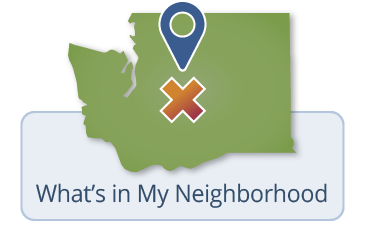Cleanup sites
In Washington state, we've identified over 13,000 contaminated sites in need of cleanup. Over 7,000 of those sites have been cleaned up, and 200 to 300 new sites are reported every year.
Find cleanup sites
What’s in My Neighborhood is a map-based search tool. Cleanup and Tank Search is text-based. Both let you filter sites by location, contaminant, cleanup status, and more. These tools also show completed cleanups.
Stay up-to-date
We publish the Contaminated Site Register every two weeks with updates about cleanups, policy, comment periods, and public meetings. You can also find events and open comment periods on our Public Input and Events page.
What is a cleanup site?
A cleanup site is a place where a toxic substance is harming or threatening humans or the environment.
Toxic substances can include:
- Petroleum (gasoline, diesel, oil, etc.)
- Heavy metals (lead, arsenic, etc.)
- Chemicals and pesticides
- Persistent organic pollutants (PCBs, dioxins, furans, etc.)
Toxic substances can contaminate multiple types of media, including:
- Soil
- Sediment (in bays, shorelines, estuaries, lakes, rivers, etc.)
- Water (groundwater, fresh or marine water, and stormwater or surface runoff)
- Air (indoor and outdoor air, soil gas, and vapor intrusion)
Under state and federal laws, people or entities who pollute the air, land, or water are responsible for cleaning up the contamination.
Types of cleanup sites
Most contaminated sites in Washington are handled by our Toxics Cleanup Program and are cleaned up under Washington’s environmental cleanup law, the Model Toxics Control Act (MTCA). Property owners may clean up sites independently or under Ecology supervision. Ecology can also clean up sites.
Some sites are exceptions because of the type of facility or contamination. They’re handled by different programs or agencies, and may have to meet additional legal standards:
- Superfund sites and some other large or highly contaminated sites are managed by the Environmental Protection Agency (EPA) under the Comprehensive Environmental Response, Compensation, and Liability Act (CERCLA), known as the Superfund. We frequently partner with the EPA to help with these sites. Sites cleaned up under federal regulations usually must meet or exceed Washington’s cleanup standards.
- Active spills of hazardous substances are handled by our Spill Prevention, Preparedness, and Response Program.
- Dangerous Waste Facilities and sites with a high concentration of certain dangerous chemicals are managed by our Hazardous Waste and Toxics Reduction Program under state Hazardous Waste Management Act and the federal Resource Conservation and Recovery Act (RCRA).
- Nuclear cleanup and radioactive waste are handled by our Nuclear Waste Program.
- Some former landfills are handled by our Solid Waste Management Program.
- Some large industrial sites are handled by our Solid Waste Management Industrial section. These sites may be cleaned up under RCRA, CERCLA, or MTCA.



